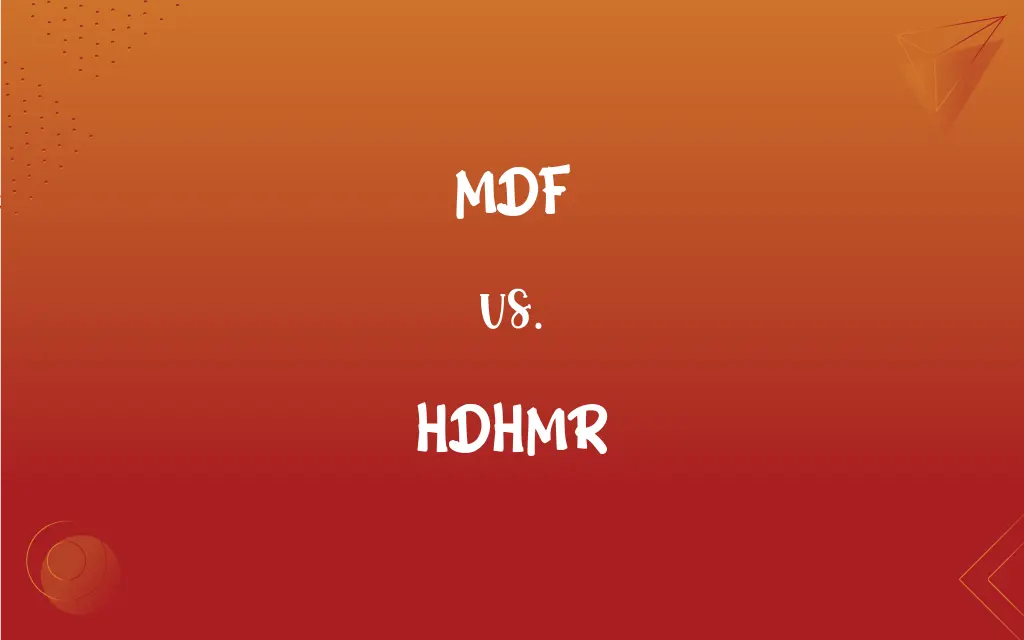MDF vs. HDHMR: What's the Difference?
Edited by Aimie Carlson || By Janet White || Published on February 1, 2024
MDF (Medium Density Fiberboard) is a wood composite made from fine wood fibers, while HDHMR (High-Density High Moisture Resistance) is a denser, moisture-resistant variant.

Key Differences
MDF, or Medium Density Fiberboard, is a common type of engineered wood made from fine wood fibers bonded with resin. HDHMR, standing for High-Density High Moisture Resistance, is a specialized form of MDF designed to offer enhanced moisture resistance and greater density. Both materials are used in furniture and cabinetry, but HDHMR is preferable in moisture-prone areas.
The manufacturing process of MDF involves breaking down hardwood or softwood residuals into wood fibers, which are then combined with wax and a resin binder. HDHMR, while similar in production, includes additional steps or materials to enhance its moisture resistance and density. These differences affect their respective suitability for various environments, with HDHMR being more robust in damp conditions.
Regarding durability, MDF is known for its smooth surface, making it ideal for painting and veneering. However, HDHMR, due to its higher density and moisture resistance, is generally more durable, especially in environments with fluctuating humidity levels. Both MDF and HDHMR can be cut and shaped with ease, although HDHMR might require more robust tools due to its density.
In terms of cost, MDF is typically more affordable than HDHMR. This is because the additional processes and materials required to manufacture HDHMR contribute to a higher production cost. Both MDF and HDHMR are used in various applications, but budget constraints often dictate the choice between the two.
Environmental considerations also differ between MDF and HDHMR. Standard MDF, while recyclable, may release formaldehyde due to its resin content. HDHMR, on the other hand, often incorporates more advanced binders and materials to reduce such emissions, making it a slightly more environmentally friendly option.
ADVERTISEMENT
Comparison Chart
Abbreviation Meaning
Medium Density Fiberboard
High-Density High Moisture Resistance
Word Length
3 words, 24 characters (including spaces)
4 words, 37 characters (including spaces)
Syllable Count
8 syllables
11 syllables
Usage in Sentences
Often used as a noun
Typically used as a noun
Complexity
Less complex, more common
More complex, less common
ADVERTISEMENT
MDF and HDHMR Definitions
MDF
MDF is used for its affordability and ease of machining.
Manufacturers often choose MDF for cost-effective furniture production.
HDHMR
HDHMR is an engineered wood product known for its durability.
HDHMR is ideal for furniture in humid climates.
MDF
MDF refers to a type of engineered wood made from wood fibers.
MDF panels are preferred for their ease of customization.
HDHMR
HDHMR stands for High-Density High Moisture Resistance, a type of MDF.
For the kitchen cabinets, we used HDHMR due to its moisture resistance.
MDF
MDF stands for Medium Density Fiberboard, a wood product.
The bookshelf is made of MDF, ensuring a smooth finish.
HDHMR
HDHMR is specifically designed for high moisture environments.
Bathroom vanities are often made from HDHMR for longevity.
MDF
MDF is characterized by its homogeneous composition and smooth surface.
MDF provides a consistent base for painting and decorating.
HDHMR
HDHMR combines the qualities of MDF with improved moisture resistance.
HDHMR flooring is more resilient to spills than standard MDF.
MDF
MDF is known for its versatility in furniture and interior design.
MDF is widely used in modern cabinetry for its smooth texture.
HDHMR
HDHMR is a denser form of MDF with enhanced properties.
HDHMR's density makes it a sturdy choice for heavy-duty use.
FAQs
What is HDHMR?
HDHMR refers to High-Density High Moisture Resistance, a variant of MDF with enhanced properties.
How are MDF and HDHMR different in use?
MDF is common in general furniture, while HDHMR is used in moisture-prone areas like kitchens.
Can MDF be used outdoors?
MDF is not ideal for outdoor use due to moisture sensitivity; HDHMR is a better option for damp conditions.
Is HDHMR more expensive than MDF?
Yes, HDHMR tends to be more expensive due to its advanced manufacturing process.
Are MDF and HDHMR environmentally friendly?
Both have environmental impacts, but HDHMR often uses more advanced, less harmful binders.
What is MDF?
MDF stands for Medium Density Fiberboard, an engineered wood product made from wood fibers.
Is HDHMR heavier than MDF?
Yes, HDHMR is denser and thus heavier than standard MDF.
Where is HDHMR most commonly used?
HDHMR is ideal for kitchen and bathroom furniture, and areas with high moisture.
Can MDF and HDHMR be painted?
Yes, both can be painted, but MDF provides a smoother surface for painting.
Can MDF and HDHMR be recycled?
Both can be recycled, but the process can be more complex due to the resins used.
Does HDHMR require special tools for machining?
Due to its density, HDHMR might require more robust tools for machining.
Is HDHMR suitable for flooring?
HDHMR is a good option for flooring, especially in areas prone to moisture.
How do MDF and HDHMR compare in terms of finishing options?
Both offer good finishing options, but MDF has a smoother surface ideal for detailed work.
How do MDF and HDHMR react to humidity?
MDF can swell or deform in humidity, whereas HDHMR is more resistant to moisture.
Is MDF suitable for load-bearing applications?
MDF is not typically recommended for load-bearing purposes; HDHMR offers better strength.
How does HDHMR perform in fire resistance?
HDHMR has better fire resistance compared to standard MDF.
Is MDF easy to work with in DIY projects?
Yes, MDF is popular in DIY projects due to its ease of cutting and shaping.
Are there different grades of MDF and HDHMR?
Yes, both MDF and HDHMR come in various grades, tailored for different applications.
What are common uses of MDF?
MDF is widely used in furniture, cabinetry, and interior decoration.
Can MDF cause health issues?
MDF can release formaldehyde; proper ventilation and safety gear are recommended during cutting.
About Author
Written by
Janet WhiteJanet White has been an esteemed writer and blogger for Difference Wiki. Holding a Master's degree in Science and Medical Journalism from the prestigious Boston University, she has consistently demonstrated her expertise and passion for her field. When she's not immersed in her work, Janet relishes her time exercising, delving into a good book, and cherishing moments with friends and family.
Edited by
Aimie CarlsonAimie Carlson, holding a master's degree in English literature, is a fervent English language enthusiast. She lends her writing talents to Difference Wiki, a prominent website that specializes in comparisons, offering readers insightful analyses that both captivate and inform.

































































